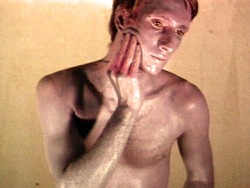Bruce Nauman
Biography
Bruce Nauman is one of the most important and influential figures in contemporary art. Working in a range of media, including neon, holography, sculpture, film, and video, Nauman is interested in art’s relationship to the audience, and to the space it inhabits.
His pathbreaking films and videos from the 1960s and '70s are among the most innovative contributions to media art. In these conceptual works, Nauman uses his body as both a subject and material, performing repetitive actions in his studio while the camera remains fixed in place. Exploiting the phenomenology of the medium, including its immediacy, space, and intimacy, his real-time gestures investigate the very process of making art.
Early videotapes, such as Bouncing in the Corner, No. 1 (1968), showcase Nauman’s embodied relationship to art making. Turning the camera sideways, he repeatedly falls into a corner of his studio and pushes himself up until the tape runs out, producing a hypnotic performance determined by the durational constraints of the videotape. Walk with Contrapposto (1968) was a pivotal work in Nauman’s career. A static camera records the artist slowly walking down the length of a narrow corridor, exaggerating the shift of weight from one leg to the other to mimic the classic sculptural pose. In 1969, Nauman reconstructed the corridor as an interactive installation for the Whitney Museum’s seminal exhibition of post-minimalism and process art, Anti-Illusion: Procedures/Materials. Nauman continued his studio-based video experimentation until 1973, when he utilized, for the first time, additional performers and multiple cameras. While he primarily focused on sculpture and installation throughout the 1970s, he returned to video in the ensuing decades.
Born in Fort Wayne, Indiana in 1941, Bruce Nauman received his B.S. from the University of Wisconsin, Madison (1964) and his M.F.A. from the University of California, Davis (1966). Between 1969–79, Nauman lived and worked in Los Angeles, becoming a key figure in West Coast conceptualism, known for its process-oriented approach, humor, and experimentation with new materials. During this time, Nauman’s work appeared in defining exhibitions of international postwar art, including documenta 4 in Kassel (1968) and Live in Your Head: When Attitudes Become Form at Kunsthalle Bern (1969).
Following a number of solo gallery exhibitions in the 1960s, surveys of Nauman’s work were held at the Los Angeles County Museum of Art and the Whitney Museum of American Art (1972-73) and the Whitechapel Art Gallery, London in collaboration with the Kunsthalle Basel and the Musée d’Art Moderne de la Ville de Paris (1986-87).
His first major retrospective, co-organized by the Walker Art Center and the Hirshhorn Museum, opened at the Museo Nacional Centro de Arte Reina Sofia, Madrid, and travelled to the Museum of Contemporary Art, Los Angeles; The Museum of Modern Art, New York; and Kunsthaus Zurich (1993-95). Other important solo exhibitions include Raw Materials, in the Tate Modern’s Turbine Hall (2004); A Rose Has No Teeth: Bruce Nauman in the 1960s at the Berkeley Art Museum, Castello di Rivoli, and Menil Collection (2007-08); and Bruce Nauman at the Fondation Cartier (2015).
His most comprehensive retrospective to date, Bruce Nauman: Disappearing Acts, opened at Schaulager, Basel in 2018 and traveled to The Museum of Modern Art, New York and MoMA PS1. In 2020, the Tate presented a survey that traveled to the Stedelijk Museum, Amsterdam (2021); M Woods, Beijing (2022); and Pirelli HangarBicocca, Milan (2022-23). Other exhibitions include Bruce Nauman: Contrapposto Studies at Palazzo Grassi – Punta della Dogana, Venice (2021-22); His Mark at SITE Santa Fe, NM (2023); and Bruce Nauman at Tai Kwun Contemporary, Hong Kong (2024). Nauman was included in the 1999 Venice Biennale and received a Golden Lion. In 2009, he returned to the Venice Biennale to represent the United States; the exhibition, entitled Topological Gardens, was awarded the Golden Lion for Best National Participation.
Nauman lives in Galisteo, New Mexico.
